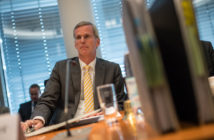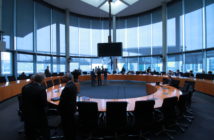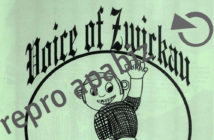Trial observers and participants and in the process had summer recess from the 7th of August until the 4th of September. At this juncture, we’ll try to summarize and recapitulate the insights and impressions made in the preceding and following trial days. The Bundestag’s investigative committee’s final report on the NSU was also published in this period. We will address this report at another point.
Structure
The NSU trial evidentiary hearings in Munich are still not organized according to subject/content, as was requested by co-plaintiff representative Kienzle on the 17th of July, but rather according to individual crimes. The subjects and groupings of crimes are still regularly switched out, and no grouping of crimes has been discussed to completion. This hinders not only the reporters but also the lawyers as they prepare themselves for the trial proceedings. It remains as emotionally challenging as it was in the beginning. The emotional challenge for attending co-plaintiffs was renewed in the middle of September when a trial day was canceled because two challenges on the grounds of bias were made; Gamze and Elif Kubaşık and two brothers and a cousin of Mehmet Turgurt traveled to Munich in vain as a result. It is difficult to surmise what kind of emotional strain this creates. Very few co-plaintiffs have participated in the process in the last few weeks. Meanwhile, after the catastrophic examination of the widow Kılıç the presiding judge Götzl has kept the situation of the family members better in mind. He now makes everyone aware before the showing of photos that are brutal or could be damaging to the victim’s privacy and makes it possible for the family members to decide for themselves if they want to stay for the documentation of the brutality of the murders.
“They ripped my heart out”
On the 37th day of the trial Ali Taşköprü, the father of Süleyman Taşköprü who was murdered on the 27th of June 2001 in Hamburg, described how he found his son at the crime scene laying in a pool of blood. The witness’s moving testimony once more brought home what occasionally threatens to be drown out in the flood of details dealt with in the hearing of evidence: the NSU took the lives of ten people, seriously injured dozens and left relatives and friends behind gravely traumatized. Ali Taşköprü answered presiding judge Götzl’s question about the consequences of the crime: “They ripped my heart out.” The business partner of Theodoros Boulgarides, who found his dead co-owner in their shared business, answered the same question on the 38th day of the trial: “I would say [the consequence is]complete devastation. Not only for the relatives.”
The Ignored Clues About Two Cyclists and White ‘Germans’
The evidentiary hearings to the individual acts of murder, although not yet completed, also made it very clear that two cyclists were seen at several crime scenes and the investigating officers never pursued these obvious leads. Already at the scene of Şimșek’s murder witnesses had seen people wearing cyclist clothing. Cyclists were scene at the murder of Habil Kılıç and finally multiple witnesses, independent of each other, had scene cyclists at the crime scene of the murder of İsmail Yaşar on the 9th of June 2005 in Nurnberg (see primarily protocol 34, but also 33 and 32). Moreover, in the video recording of Keupstraße, as is well known, cyclists can be seen with the bomb, and a witness already mentioned their similarity with the cyclists in Nurnberg before the NSU became public. Furthermore, Ali Taşköprü had seen at least two white men (“Germans”) in Hamburg.
Institutional Racism
Ignorant and amateur are not the only appropriate words to describe the investigative work of some officers. Despite racism in government agencies being publicly addressed, we repeatedly had officers in the last few examinations that relentlessly held to their opinion that they performed excellent work.
The testimony of officials as well as witnesses and family members showed that clues were not only neglected, but also that the victims and family members were seriously investigated. In this process, no apparent costs or efforts were spared. For example, the officers used surveillance equipment and even and undercover officer against the family of Halit Yozgat while investigating his murder on the 6th of April 2006 in Kassel. The investigator that was examined on the 39th day of the trial about the Yozgat case even had the audacity to describe the relationship of the police to the family as “harmonious cooperation.” To this comment co-plaintiff lawyer Alexander Hoffmann: “Here sits a police official in September 2003 – more than seven years after the murder of Halit Yozgat in Kassel – as a witness before the court and he cheerfully explains how good the relationship between the family of the murdered man and his investigation team was; how approachable and open the family was. That the police investigation was, in essence, directed against the family […] is for this officer neither a contradiction to this claim […] nor a reason to feel regret for his unsatisfactory investigative work.” The investigators apparently studiously ignored the suggestion from Halit Yozgat’s father that there could be a racial motive. Again, attorney Hoffman: “Its clear that this official, even today, does not understand that his investigation squad ‘Café’ impeded more than facilitated the clearance of a crime.”
The testimony of detective chief superintendent Hänßler was surprising in this context. He alleges to have proceeded on the assumption that there was a racial motive since 2005 and that this estimation was basically shared in the “BAO Bosporus.” This can ultimately only be an unabashed attempt to cover himself. Investigations from his side also ran almost exclusively against the families.
The “State’s Witnesses” Holger G. and Carsten S.
If the defendant Holger G. will contribute any further necessary explanations has remained open in the last week. It is unclear if G. will get involved once again (see protocol 33). G. would obviously like to gain something from the so-called “states witness regulations,” according to which he could receive significantly milder sentencing if he contributes essential testimony. He accepts, however, that his merely reading aloud of pre-formulated explanations can be construed as partially not testifying. In this manner G. contributes very little to the understanding of the NSU-complex. Moreover, some things suggest that G. is not telling the truth in regard to his alleged exit from the Nazi scene. These circumstances throw poor light onto the other information he gave. Co-plaintiff attorney Sebastian Scharmer speaks to this in a press release: “ Holger G. runs in this respect the risk of significantly relativizing the ‘penal rebate’ he expects in exchange for his previous testimony because of his conduct during the trial […] quick comes to mind that Holger G., in the scope of a crucial interrogation, share details that more seriously incriminate him that before.” The defendant Carsten S. made the surprise announcement on the 36th trial day that he would now answer questions from Ralf Wohlleben’s defense, something he had previously always refused. This is planned to occur on the 10th of October.
The Frühlingsstraße Crimes
The Frühlingsstraße crimes are almost completely dealt with since the examination of the arson investigators in regard to the fire on Frühlingsstraße is now finished, which lasted several days. A rough picture resulted from the testimony of the witnesses from Zwickau’s Frühlingsstraße: Beate Zschäpe was scene by several witnesses as she escaped shortly after the explosion in the arsoned house. In the act, however, she still found the time, according to witness testimony, to bring her cats to safety with neighbors on the street. There is much in this point and about her escape that remains unclear: How did Zschäpe find out that Uwe Mundlos and Uwe Böhnhardt were dead? Was she helped while she was on the run and if yes, by who?
The witness Olaf B. gave in his testimony insight into the immediate environment, and respectively into Zschäpe’s “underground”-life on the 27th day of the trial. Olaf B. lived in the other half of the duplex home on Zwickau’s Frühlingstraße at 26/26a. He reported how he drank regularly with friends in the basement of his side of the house and that Beate Zschäpe, who he called the “Dienelt mouse,” joined every once and a while and drank Prosecco. This all occurred under a picture of Hitler that stood on the windowsill, although B. wants it know that it [the picture]means nothing political.
It became clear during the examination of other witnesses that, at the time of the fire, there should have been, as it was normally scheduled, a coffee date between the almost 90-year-old resident and her nieces. The apartment shared a wall with Zschäpe, Mundlos, and Böhnhardt’s apartment. The arson and the following explosion would have not only endangered the two handymen and the 89-year-old neighbor, but also her visitors.
The multi-day examination of the arson investigators, along with the exhibiting of over 1,000 photos gave insight into life in the so-called ‘underground.’ Visible next to weapons, explosives, and bank wrappers from various financial institutions were also various identification documents with different aliases. Particularly macabre was the tacked-together portfolio, in which newspaper cuttings of the crimes were numbered and preserved like trophies. The attentive listener notices that some of the clippings preserved by the NSU were articles from local or regional papers where the crimes were committed. This could be an indication of support by local neo-Nazis.
New Leads
Co-plaintiff attorney Doris Dierbach surprised the court on the 36th trial day with an application to hear evidence from a witness that saw Mundlos Böhnhardt, Zschäpe and an unidentified ‘Skinhead” in Dortmund around the time of the murder of Mehmet Kubaşık on the 4th of April 2006. The witness was heard on the 30th of September. Should her testimony prove to be true, it would be a decisive moment for the whole trial. First it would give the first strong evidence of an inclusion of local neo-Nazis and secondly it would bring the defendant Zschäpe for the first time into the chronological and geographical context of a murder.
The Presence of Neo-Nazis
The media, family members, and observers enjoyed a relatively long reprieve from the presence of observing neo-Nazis in the Munich regional high court. However, the number of familiar and unfamiliar neo-Nazis – while not known, they are recognizable through their neo-Nazi clothing and public friendship with the defendant André E. – attending has increased since September. The neo-Nazi scenes in Thuringia and Bavaria preach open solidarity with the defendants (“they have no regrets”) and individual comrades prove their solidarity with their physical presence at the high court. André E.’s manner is becoming bolder. He moves casually between the co-plaintiffs and their attorneys as well as the visitors to the trial on the plaza in front of the court building. Daily, he spends the break there with or without neo-Nazi company. On the 37th day of the trial he ran by a group of family members unnecessarily close, amongst whom was the brother of murder victim Süleyman Taşkörprü, who was provoked by the act.


